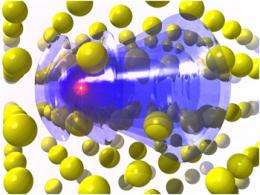Study identifies precise measurement of radiation damage

(Phys.org) -- Lawrence Livermore National Laboratory researchers have for the first time simulated and quantified the early stages of radiation damage that will occur in a given material.
"A full understanding of the early stages of the radiation damage process provides knowledge and tools to manipulate them to our advantage," said Alfredo Correa, a Lawrence Fellow from Lawrence Livermore National Laboratory in the Quantum Simulations Group.
Nuclear radiation leads to highly energetic ions that can penetrate large distances within matter, often times leading to the accumulation of damage sites as the projectile passes through the material.
During this process, the energetic ions eventually slow down as energy is lost by friction with the materials' electrons. Like a speedboat moving through a calm body of water, the passage of fast ions creates a disturbance in the electron density in the shape of a wake.
Correa along with colleagues Alfredo Caro from Los Alamos National Laboratory, Jorge Kohanoff from the UK, Emilio Artacho and Daniel Sánchez-Portal from Spain, have directly simulated this quantum friction of the electrons in a real material for the very first time.
The team simulated the passage of a fast proton through crystalline aluminum. By accounting for the energy absorbed by the electrons and the magnitude of the impulse given to the aluminum atoms, the team was able to predict the rate at which the proton is stopped and the amount of momentum transferred. This is a precise atomistic simulation of the deposited energy and momentum, which is ultimately responsible for the damage that is produced in the material.
The new method opens up the possibility to predict the effect of radiation on a wide range of complex materials. The research not only applies to materials for nuclear applications, but also for materials related to the space industry, and new processing techniques for lasers and highly energetic ions. In biology and medicine, it also may contribute to understanding the effects of radiation on living tissues, both for damage and therapeutic processes.
In a broader sense, the new simulation capability represents the first step toward a unified method for the simultaneous simulation of electron and ion dynamics. The research is highlighted on the cover of the May 25 issue of Physical Review Letters.
Journal information: Physical Review Letters
Provided by Lawrence Livermore National Laboratory



















